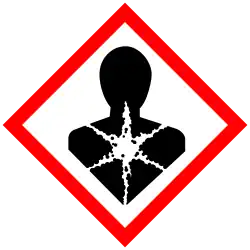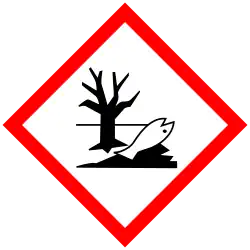Hydrazobenzene
 | |
| Names | |
|---|---|
| Preferred IUPAC name
1,2-Diphenylhydrazine | |
Other names
| |
| Identifiers | |
3D model (JSmol)
|
|
| ChEMBL | |
| ChemSpider | |
| ECHA InfoCard | 100.004.149 |
| EC Number |
|
PubChem CID
|
|
| UNII | |
| UN number | 2811 |
CompTox Dashboard (EPA)
|
|
| |
| |
| Properties | |
| C12H12N2 | |
| Molar mass | 184.242 g·mol−1 |
| Melting point | 123–126 °C (253–259 °F; 396–399 K)[1] |
| Hazards | |
| GHS labelling:[1] | |
  
| |
| Danger | |
| H302, H350, H410 | |
| P203, P264, P270, P273, P280, P301+P317, P318, P330, P391, P405, P501 | |
Except where otherwise noted, data are given for materials in their standard state (at 25 °C [77 °F], 100 kPa).
Infobox references
| |
Hydrazobenzene (1,2-diphenylhydrazine) is an aromatic organic compound consisting of two aniline groups joined via their nitrogen atoms. It is an important industrial chemical used in the manufacture of dyes, pharmaceuticals, and hydrogen peroxide.[2]
References
- ^ "Hydrazobenzene". Sigma-Aldrich.
- ^ "Hydrazobenzene" (PDF). Report on Carcinogens, Fourteenth Edition. National Toxicology Program, Department of Health and Human Services. Retrieved June 21, 2017.